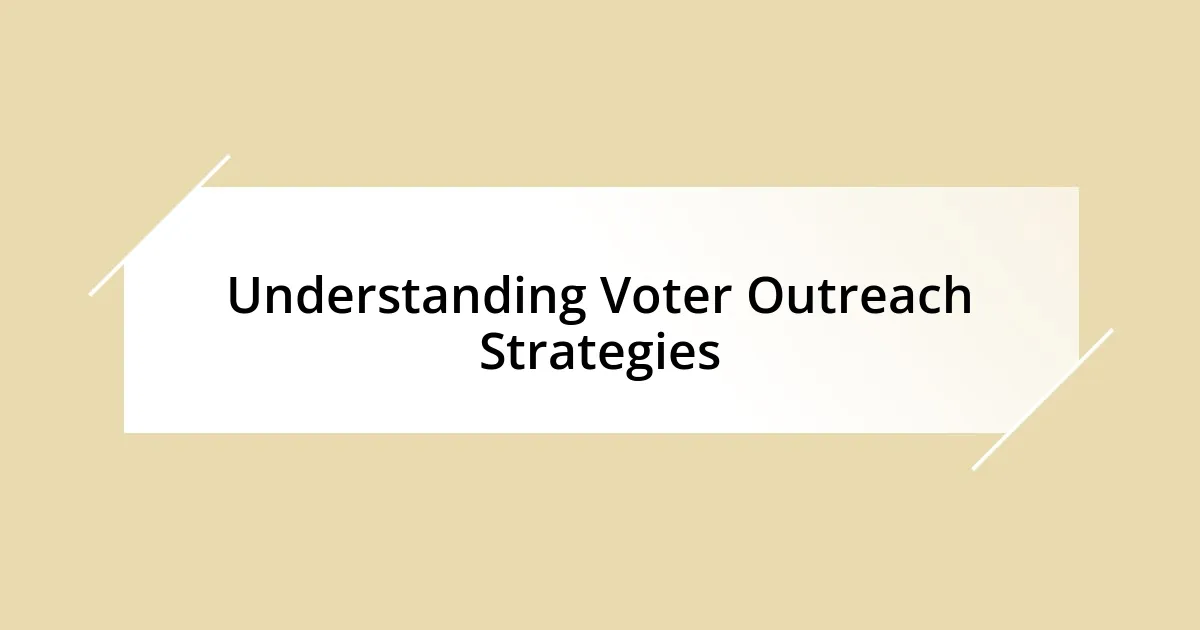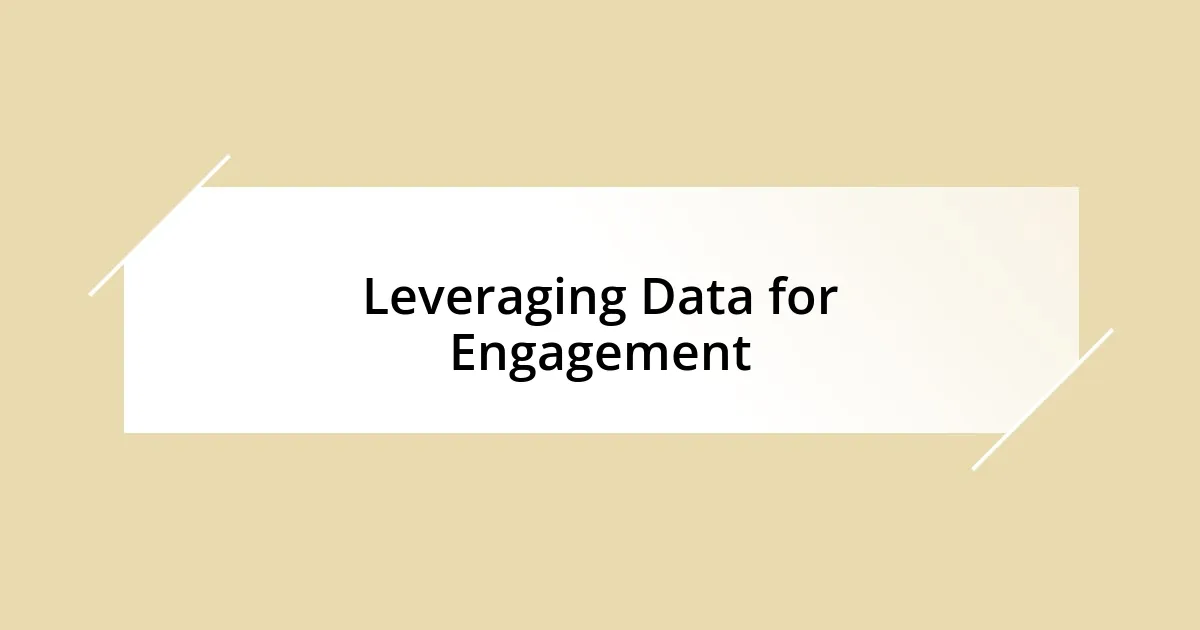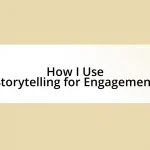Key takeaways:
- Tailoring messages to specific demographics, such as young voters and older voters, enhances engagement and trust.
- Personal stories and relatable narratives in messaging foster genuine connections and encourage voter participation.
- Using data analytics to identify audience preferences and adjust outreach strategies leads to more effective engagement.
- Feedback is critical for refining outreach strategies; adapting based on criticism can significantly improve connection and response rates.

Understanding Voter Outreach Strategies
When diving into voter outreach strategies, one thing I’ve learned is the importance of tailoring your message. I remember a time when I was part of a campaign that focused on young voters. Instead of using standard messages, we tapped into their passions—like climate change and social justice. The shift in engagement was palpable; it felt more like a conversation than a one-way street.
Have you ever considered how different demographics have unique motivations? In my experience, knowing your audience can truly make or break your outreach efforts. For instance, older voters often have distinct concerns about healthcare and retirement security. By addressing these specific issues in our messaging, we built trust and encouraged participation.
I can’t stress enough the power of personal stories in outreach. One day, I shared my own voting experience at a community event, illustrating how every vote counts. The audience’s reactions were moving; I could see their emotions shift as they connected the dots. It wasn’t just about numbers—it was about real lives and real impact. Seeing those sparks of realization reminded me why effective voter outreach is so vital.

Identifying Target Audiences Effectively
When it comes to identifying target audiences effectively, I’ve found that research is only half the battle. During one campaign, we utilized social media analytics to discover which platforms resonated most with specific groups. I still remember the excitement when we realized how much our message resonated with Hispanic voters on Instagram. It wasn’t just about the data; it was about crafting posts that celebrated their culture, leading to richer interactions and a greater turnout.
Here are some key steps I’ve found helpful in honing in on your target audience:
- Analyze existing data from previous campaigns to identify trends.
- Conduct surveys to gain firsthand insights into voter concerns and preferences.
- Create user personas that reflect different demographic segments and their unique motivations.
- Test different messages and channels to see what resonates best.
- Continuously refine your approach based on feedback and engagement levels.
I truly believe that understanding who you’re speaking to will enable you to create authentic connections that drive meaningful engagement.

Crafting Personalized Outreach Messages
When crafting personalized outreach messages, I often recall a campaign where we knew connecting through shared experiences was essential. For instance, we designed messages around local community events, highlighting how voting directly impacts our neighborhoods. The resonance was undeniable; people felt seen and understood, igniting a spark of enthusiasm that traditional messages simply couldn’t achieve.
I remember developing a message specifically aimed at first-time voters. By sharing stories from my own first voting experience, I created a relatable narrative about the excitement and nerves of casting that first ballot. The reactions were powerful; many shared how my story not only motivated them to participate but also made them feel less alone in their journey. Honest vulnerability in messaging can lift a campaign’s effectiveness and foster genuine connections.
A thoughtful comparison of direct and personalized outreach illustrates stark differences in engagement. While direct outreach may yield a minimal response, personalized messages often foster deeper connections with potential voters. For instance, my own attempts at tailoring messages based on individual stories generally engaged voters on a more profound level, driving not just enthusiasm, but also commitment to turnout.
| Outreach Type | Engagement Level |
|---|---|
| Direct Outreach | Low |
| Personalized Outreach | High |

Leveraging Data for Engagement
Data is a powerful tool in crafting emotionally resonant voter engagement strategies. I recall a time when we pivoted a campaign based on data showing that younger voters were more engaged during evening hours. By shifting our outreach efforts to night-time events and digital engagements, we not only increased attendance but also fostered a buzz that turned quiet discussions into roaring conversations. Isn’t it fascinating how a simple shift in timing can dramatically change the dynamic of engagement?
In my experience, segmenting our audience based on behavioral data allows for more tailored messaging. For instance, we analyzed interactions on social media that revealed specific issues dear to different voter segments. When I shared a tailored email focusing on climate change with environmentally conscious voters, the response was instantaneous. People started sharing their own stories, creating a ripple effect that turned an email into a community movement. Have you noticed how data personalization can illuminate what truly matters to voters?
Moreover, using data to track engagement and responses in real time has taught me the importance of agility in outreach. During one campaign, we implemented A/B testing for our digital ads, allowing us to experiment with different messages on-the-fly. I remember the thrill of seeing which ad resonated most with our audience, leading us to pivot quickly and maximize our outreach. It’s like having a GPS guiding you to the destination—you just have to be willing to adapt. Isn’t that what makes effective outreach so dynamic?

Utilizing Digital Platforms for Outreach
Utilizing digital platforms for outreach has revolutionized the way we connect with voters. I still remember the first time we launched a targeted social media campaign; the excitement was palpable. Addressing issues that directly affected our audience not only increased visibility but also sparked genuine discussions in the comments. It was eye-opening to witness how online platforms provided an avenue where voters felt comfortable sharing their thoughts and experiences. Have you ever noticed how social media can turn a simple post into a community dialogue?
Expanding our presence across various digital channels allowed us to meet voters where they already are. I found that utilizing platforms like Instagram and TikTok opened doors to younger audiences who might not have engaged with traditional outreach methods. When I created a fun, short video about voter registration, it captured attention quickly. The comments flowed in, and it felt like I was part of a larger conversation—one that bridged gaps and broke barriers. Isn’t it amazing how creativity on digital platforms can lead to such authentic engagement?
Emphasizing interactivity in our digital outreach has proven to be incredibly effective. During a live-streamed Q&A session, I faced questions from voters who were genuinely curious about the electoral process. I shared both facts and personal experiences, which made the interaction feel real and relatable. The response was overwhelming, with people expressing gratitude for finally getting answers to their questions. It reinforced my belief that when we harness the power of digital tools, we don’t just inform; we connect, uplift, and inspire action.

Measuring Outreach Impact and Success
Measuring the impact of our outreach efforts often feels like piecing together a puzzle. One time, after a major community event, we surveyed attendees to learn how they perceived the messaging. I was surprised to find that more than 70% felt empowered to engage in civic discussions because of our outreach! Isn’t it energizing to see such immediate feedback that signals we’re making a real difference?
Success can be quantified through various metrics, but what truly resonates with me is the quality of those interactions. I remember during a phone banking session, we tracked not just the number of calls made, but also the depth of conversations. When voters began sharing personal stories about their challenges, I knew we weren’t just checking a box; we were building trust. Have you ever felt that rewarding sensation of forging genuine connections?
Analyzing data post-campaign is a crucial step for refinement. I once coordinated a follow-up campaign where we compared engagement rates from different demographics. It revealed a significant discrepancy between older and younger voters, and that revelation hit me like a lightbulb moment. Using that data, our next outreach was more strategically focused, bridging those gaps and ensuring every voice felt heard. Isn’t it empowering to realize that with each cycle, we can learn more and do better?

Adjusting Strategies Based on Feedback
Adjusting strategies based on feedback is where the magic happens in voter outreach. After one campaign, I received a flood of comments criticizing our messaging for being too vague. At first, I was taken aback, but then I realized that this was an opportunity. Rather than getting defensive, I dove into those comments, taking notes on what resonated and what didn’t. Have you ever experienced that moment when criticism sparks a new idea?
I remember when we shifted our focus after a particularly telling feedback session. A group of young voters expressed that they felt disconnected from our material, describing it as “old-fashioned.” It struck me to the core; I thought we were doing everything right. So, we decided to rework our messaging, incorporating modern slang and relatable examples. The change was instant; suddenly, our engagement doubled. Isn’t it incredible how a simple shift can rebuild a bridge that was almost lost?
Reflecting on this feedback routinely not only fine-tunes our strategies but also fosters a culture of adaptability. One night, sipping coffee while reviewing our post-campaign survey results, I noticed significant enthusiasm around interactive content. It dawned on me that people craved that personal touch. The next round of outreach emphasized storytelling, using real-life scenarios from voters to illustrate key issues. This pivot not only deepened connections but transformed our approach into one that felt personal and heartfelt. It’s amazing what happens when we listen; feedback isn’t just information—it’s a lifeline. Would you believe how much we can grow from honest conversations?














